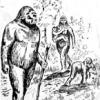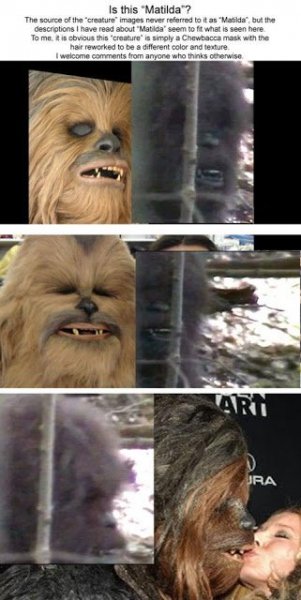Leaderboard
Popular Content
Showing content with the highest reputation on 06/05/2019 in all areas
-
I work with both the BFRO and the Olympic Project and bottom line is the investment Wally has made did not go very far and in some cases was misused ( he contributed to many projects and individuals ). He has since stepped back from the subject ( at least on the investment level as there has been no fruit for the labor ) and is currently occupied with more important matters. The nest site information is still under review, new samples (not fresh just newly collected ) have been collected from the location and are currently being examined. That is all I can say at this point. The bigfoot subject has always been wishy-washy, it swallows loads of time and money and does not produce much. These days money does not get dumped into research efforts and instead gets wrapped up in the frauds and poorly crafted plans that fall apart before they even take flight. I would know, I have been caught in the middle of it myself. What really needs to happen is for money to be put down on the people willing to be out there and have boots on the ground following proven methodology. That has not happened yet ( the tom slick expeditions had no mold or defined field practices ).2 points
-
Glad to hear you're getting out, norse. I got out Sunday for a long drive through some less travelled high country, with my youngest boy and his girlfriend along to make sure this old fart made it back home. We did the traverse from Harrison East FSR over Kookipi Pass to the Nahatlatch Valley, an older deactivated logging road that made travel very slow due to the frequent cross ditching and washouts. We didn't see anything other than some does and a bunny, but it was a beautiful day, with some spectacular scenery. Lots of deer tracks and bear scat, but no Sasquatch sign.2 points
-
I am hoping for better discussion than an essay by S. Hill, who mainly addressed pre-publication press release of information (yes the Ketchum study was published; it was peer reviewed; the peer reviews were leaked at the time but have since been made public) with much conjecture, ad hominem attacks, and most significantly, not addressing much in the way of data or conclusions based on data. The Hill essay perfectly exemplifies my aversion to the reliance of biased discussion void of fact. What is her evidence that the three samples leading to Ketchum's conclusions (really the gist of the study) were not collected and examined with rigorous procedure? Conjecture. Most opponents (e.g. Disotell) point to the mitochondrial DNA testing as Homo sapiens as being due to contamination, but of course if Sasquatch exhibits H. sapiens mtDNA then that is a classic Catch-22 for which there will never be an argument (the same argument is raised in rape and murder legal cases involving people, but people are still convicted with DNA - and rightly so). To my knowledge (someone please correct me if I am wrong) Disotell has never tested nDNA purported to be Sasquatch (or perhaps any other organism) - to my knowledge Sykes either. Actually the Q30 analyses argue definitively for lack of contamination, as do the results of the testing of nDNA. I think the DNA sequence from these three pertinent DNA samples should have been saved in kind of a "provisional Genbank" against which other existing samples and future samples could be compared. At some point (after 10 successful comparisons, 100 successful comparisons, 1000 successful comparisons?) anthropologists and primate scientists would have to start taking notice, and some would get involved.2 points
-
1 point
-
Sorry we differ on opinions, she is a sore subject for me, I have personal experience of how she treated her "contributors" might I add. Maybe Paulides and you fell for it, but I never did! If I might ask, what personal experience do you have with Ketchum?!1 point
-
Sorry, the biggest influence on Ketchum was making money and saving face (purportedly) not solving the Sasquatdh mystery. Let's tell it like it is. Since when did she have a team, I thought it was an amalgam, loosely called a cult!1 point
-
Right. She was rejected by the scientific community. So she published on her own website and charged 30 bucks a head for people to read it. She surrounded herself with patsies that all nodded their heads in agreement that the findings were really really an unknown primate. This is not science.... this is a Barnum Bailey freak show. I understand that science bias can be harsh. But if she had a tooth that was morphological different from a Homo Sapien tooth or anything tangible to point to? I would take her way more seriously.... By peripherals? Do you mean the hoax known as Matilda? This is pretty central and damning in my book. Ketchum gave a sample to the Houston chronicle for independent verification. What did they find? Manbearpig. https://www.the-scientist.com/the-nutshell/bigfoot-samples-yield-opossum-dna-39073 Am I emotional about it? Absolutely. I take it personal when people attempt to hood wink this community. We have a hard enough time with the scofftics without people like Ketchum, Dyer or Standing or Biscardi mucking it up worse for us for 5 minutes of fame. I think the rule of thumb should be to not trust people trying to sell you something. That’s what I think.1 point
-
There seems to be a fair bit of emotion in your response and questions? I will try to answer, although I think your questions may be rhetorical rather than an attempt to gain additional understanding. Normally I wouldn't respond to such, but I will try to here out of my respect for you as a thoughtful forum representative that has a knack for garnering pertinent information from a wide variety of sources. The peer review process in professional journals has been consistent for a number of recent decades. Each journal has a group of experts in the field that have volunteered, or have agreed to be involved after solicitation, to serve as reviewers. They normally do this to help keep the journal viable and with a sense of loyalty to their respective specialty. Normally a paper is submitted to 3 reviewers. The reviewers name is normally not divulged to the authors (I experienced two instances where reviewers contacted me personally - without the journal adviser's knowledge - because I was in the clique, that is, I was part of the "in crowd" involved in that particular area of research. Believe me, Ketchum was not part of the "in crowd"! In fact, just the opposite; she was as out as an "out crowd" person could be). So you and no one other than the journal editor knows who the reviewers were and whether or not they were "Ketchum patsies". I supplied links to all the reviewers and their comments, so your question puzzles me, but to continue. The article was sent to three reviewers at Nature. Each responded with comments, criticisms, suggestions, and corrections. The authors resubmitted the paper with the suggested corrections made. The modified paper was sent to those same three reviewers, each of whom then responded again with different comments, criticisms, suggestions, and corrections. Anyone who has read those reviews has likely become aware of the painfully pedantic process in this case. The process likely took well over a year just for Nature just to reach a point where publication was not going to happen (even reviews that are returned as "Publish as is", sometimes take 6 months to a year. That is because, reviews are usually low on a reviewer's priority list, what with the responsibilities of teaching classes, doing one's own research, writing papers, submitting papers to journals, dealing with the politics of department and university administration, etc.). Publication in Nature was a lofty goal. I think that choice was likely made because of Nature's prestige, wide circulation, broad subject range, and the fact that it is European (there is a feeling among scientists that Europeans are less close-minded than Americans, at least as it relates to cryptids). The paper was then submitted in its updated form to the Journal of Advanced Zoological Exploration in Zoology (JAMEZ). The paper was sent to reviewers for review, and in January 2013 it passed review for publication slated for January 11, 2013. On January 10, 2013 JAMEZ notified Ketchum that the journal was rescinding its commitment to publish the paper. To enter into a discussion of why that occurred would be to enter into a world of conjecture, but I have my own ideas. So Ketchum purchased JAMEZ, renamed the journal Denovo, and published the paper. It is available online in its entirety for review by Norse, by 9-dot, by the original Nature reviewers, by the JAMEZ reviewers - in fact it is available for review by 7.5 billion potential reviewers. The words won't change, the methodology in the paper won't change, the ideas put forth won't change, without regard to who reviews it. So that is what I know of "who reviewed the paper" and "where was it published". Regarding other questions comments, I think it is unfortunate that Ketchum included what I would call peripheral (and distracting) items. The salient points of the paper, in my estimation, that should be targets for discussion, both positive and negative, should be: 1) 113 mtDNA samples with chains of command pointing to Sasquatch have sequences identifying as Homo sapiens and 2) three nDNA samples with chains of command pointing to Sasquatch have sequences identifying as a combination of Homo sapiens and unknown primate. (The fact that the studied three nDNA samples each lacks two genes that are known to occur in all human DNA is a subpoint that is difficult to ignore).1 point
-
1 point
-
Where was it published? Who peer reviewed it? All Ketchum patsies and her own website to boot. Where is the species that supposedly bred with a European 13000 years ago in North America to produce Matilda the Chewbacca masked hybrid sample giver? I was hoping that no one gave any credibility to this gooblegok nonsense either....but here we are. Utter pathetic nonsense. Here is what our very own Bill Munns had to say about Matilda.... http://bigfootevidence.blogspot.com/2013/02/bill-munns-is-this-matilda.html The source the "creature" images never referred to it as "Matilda", but the descriptions I have read about "Matilda" seem to fit what is seen here. To me, it is obvious tihs "creature" is simply a Chewbacca mask with the hair reworked to be a different color and texture. I welcome comments from anyone who thinks otherwise. Using common sense? Does Chewbacca look half human to you?1 point
-
Still catching up on this thread, it sounds like you ended up on some poorly executed expeditions. I had heard from several others that the expeds between Iowa and Wisconsin kinda missed the marked for many folks. I am sorry that in you case the information was not gone over or presented. If Sasquatch are anything like all the other primates then curiosity and self preservation can draw their attention, often they seem compelled to scope out potential threats or evaluate a situation looking for some kind of advantage ( food, entertainment or displaying dominance ). The sounds either can be an outright curiosity draw or possibly fool any individuals nearby into thinking another Sasquatch may have entered their territory and thus respond. I am going to quote something I wrote about this a few months back regarding what these expeds are for and what you can expect to learn ( assuming your organizer has their head on straight ). --- The BFRO does not guide you out to gander at Sasquatch the way people do at animals in Yellowstone and nor do we put you on a pack-horse into the most remote locations where a tire may not have met the road in a decade to prepare for a 6 month grant program to be the next Jane G. This is a common misconception of what we are about as an organization ( I am not speaking for ever single expedition or organizer, some members have their own code of ethics and conduct ). The BFRO as a whole provides a form of education on the entire subject and how it relates to area ecology and history. Folks have the opportunity to learn and connect with BFRO members for guidance on some of the points below. We provide attendees to accessible locations that repeatedly generate reports at particular times of the year, we put people in the best position possible to have an experience but we do not promise anything except research methodology and environmental education. We give directed presentations on witness evaluation, reported behavior, field operations, implementation of thermal/audio technology and basic ecology. We also offer classes on habitat evaluation, report documentation, data mapping, track casting, DNA collection and nighttime observation. We offer perspective, knowledge, methods, tools and hands on experience so you can go out on your own and maximize your odds of encountering these animals.1 point
This leaderboard is set to New York/GMT-05:00








